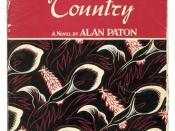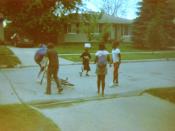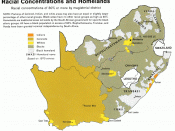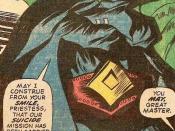In the 1940s, South Africa was under the cloud of violence and racism. "Cry, The Beloved Country"ÃÂ gives the reader the perfect perspective on the breakdown in the native tribe, the cause of violence in South Africa and the restoration of South Africa.
The Tribal breakdown started when the whites pitilessly pushed the blacks out of their hometown where the land was so rich that it could be even referred as "holy, being even as it came from the creator"ÃÂ (Pg 3) As a result of making the blacks live in confined area where the land was " sharp and coarse, and the stones cut under the feet. It is not kept or guarded, or cared for, it no longer keeps men, guards men, cares for man"ÃÂ (Pg 3), starvation and frustration fell upon on the blacks. But their desire for a better life and a justified society was not extinguished under the tremendous oppression, which they had to endure.
Because of the poor conditions in the tribe, those vigorous black men reluctantly left the tribe to travel to Johannesburg where still had the sign of life. Unfortunately, the old and children were left behind, and they floundered in desperation and pain.
Kamulo who arrived in Johannesburg to search for his son Alsalom realized that nobody in his family neither brother, sister and cousin had no support and consolation with each other. His brother was immersed in the belief of power, money and greed, and his sister lived in a horrible life. As a matter of fact this breakdown shattered the native tribes and families into pieces. Eventually, dissatisfaction and indignation aroused the blacks' desire to revenge on the whites.
Violence between the blacks and the whites was caused by a major lack of jobs for the blacks, and the law of separation towards the blacks, which forced them to fight for housing and other basic necessities that whites received easily. The blacks constantly "have no place to go"ÃÂ(Pg 53) for housing. Food was not sufficient to feed each family member. Patients went to the hospitals that had no beds and medicines for their treatments. Even if the blacks and the whites had the same job, the blacks received a much lower wage. These factors significantly intensified the blacks' resentment towards the whites and the government. But the most important factor was that the whites tried to protect their social position and power against the blacks, on the other hand, the blacks furiously fought for equal rights and freedom. Hatred and desperation continuously build up to the limit, finally, riot and murder constantly broke out between the two communities. As the confrontation dragged on, people started realizing the value of peace and justice.
Alan Paton expressed a situation in which the factor of color seemed vacant. When Kumalo was in the mission house, he observed that the "black and white priests are eating together"ÃÂ (Pg 104). Paton involved this incident to show that blacks and whites could co-exist peacefully. The relationship that developed between James Jarvis and Stephen Kumalo was another Paton's idea of what needed to come about in order to revitalize the desolater land. The bond that had to emerge between the two different colors would bring cooperation, understand and forgiveness to each other. This relationship was substantial to the revival of the country. Gertrude's son, Jarvis' grandson, and Kumalo's unborn grandchild represented the new generation that could help to heal this dying and beloved country.
"Cry, The Beloved Country"ÃÂ which urges the population of South Africa to abandon the injustice and racial hatred helps the reader to have a vivid view on the disintegration in native tribe, the cause of violence and the revitalization of South Africa.





